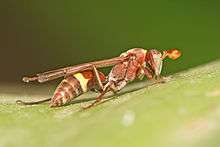Polistinae
| Polistinae | |
|---|---|
 | |
| Polistes species with nest | |
| Scientific classification | |
| Kingdom: | Animalia |
| Phylum: | Arthropoda |
| Class: | Insecta |
| Order: | Hymenoptera |
| Suborder: | Apocrita |
| Superfamily: | Vespoidea |
| Family: | Vespidae |
| Subfamily: | Polistinae |
| Tribes | |
The Polistinae are eusocial wasps closely related to the more familiar yellow jackets, but placed in their own subfamily, containing four tribes; with some 1100 species total, it is the second-most diverse subfamily within the Vespidae, and while most species are tropical or subtropical, they include some of the most frequently encountered large wasps in temperate regions. They are also known as paper wasps, which is a misleading term since other wasps (including yellow jackets) also build nests out of paper, and because some epiponine wasps (e.g., Polybia emaciata) build theirs out of mud,[1] nonetheless, the name "paper wasp" seems to apply mostly, but not exclusively, to the Polistinae, especially the Polistini. Many wasps, such as Polistes fuscatus, Polistes annularis, and Polistes exclamans, make their nests out of paper. Polistes annularis suspends its paper nests from cliff overhangs via a pedicel, whose free fatty acids induce the necrophoric response in ants and causes them to avoid the pedicel rather than cross and prey on the nest’s inhabitants.[2] Polistes metricus foragers take off from their nests as if they already know how long their trip is. For short flights, they exit the nest flying horizontally, while for long flights they exit the nest flying straight up into a high altitude before pursuing their direction.[3] Polistine brood cells are arranged in a hexagonal array, similar to the comb structure in a honey bee nest. At least one epiponine species (Brachygastra mellifica) stores honey in the comb, one of the only insects other than bees to store honey.

Characteristics of the Polistinae are:
- The queens (reproductive females) are morphologically similar to workers, though sometimes slightly larger or differently colored.
- The abdomen is spindle-shaped, often petiolate.
- The antennae of males are curled.
- The nest is sometimes open (the nests of vespines are typically enclosed in several layers of paper).
- Wasps have stingers, and their sting hurts. Some people are very sensitive to wasp stings, and wasp stings can be fatal.
Colony lifecycle

Polistine wasps found colonies in one of two ways. In some species, nests are founded by a small number of reproductive females, possibly a single one. One of the foundresses eventually acquires dominance over the other and is the sole reproducer. The nest is open (not enclosed by an envelope) and contains a single comb.
In the other group, called "swarm-founding", the nest is founded by a large number of workers and a few queens. It is usually protected by an envelope, like a vespine nest.
Selected species of Polistinae

Tribe Polistini
- Genus Polistes
- P. adelphus
- P. annularis
- P. atrimandibularis
- P. bellicosus
- P. biglumis
- P. bischoffi
- P. carolinus - red paper wasp
- P. chinensis - Chinese paper wasp
- P. dominula - European paper wasp
- P. fuscatus - northern paper wasp
- P. humilis - common paper wasp
- P. instabilis
- P. japonicus
- P. semenowi
- P. sulcifer
- P. tepidus
Tribe Mischocyttarini
- Genus Mischocyttarus
- M. collarellus
- M. flavitarsis
- M. labiatus
- Mischocyttarus drewseni
Tribe Epiponini
- Genus Agelaia
- Genus Apoica
- Genus Brachygastra
- Genus Leipomeles
- Genus Parachartergus
- Genus Polybia
- P. emaciata
- P. occidentalis
- P. scutellaris
- P. sericea
- Genus Synoeca
- S. chalibea (often misspelled as chalybea)
- S. cyanea
- S. septentrionalis
- S. surinama
- S. virginea
Tribe Ropalidiini
- Genus Ropalidia
- R. marginata
- R. revolutionalis
- R. romandi
References
- ↑ O’Donnell S and Jeanne R.L. 2002. The nest as fortress: defensive behavior of Polybia emaciata, a mud-nesting eusocial wasp. 5 pp. Journal of Insect Science, 2:3.
- ↑ Espelie, Karl (1990). "Surface Lipids of the Social Wasp Polistes Annularis (L.) and Its Nest and Nest Pedicel". Journal of Chemical Ecology. 16: 1841–1852. doi:10.1007/bf01020498.
- ↑ Dew, Heather (1978). "Foraging Flights of Two Species of Polistes Wasps (Hymenoptera: Vespidae)". Journal of the Kansas Entomological Society.
External links
- Social Behavior of Polistine Wasps
- Article on Australian Paper Wasps
- Nest defence behavior in two species of Polybia
- Ropalidia marginata a primitive eusocial wasp
- Iconography of the Vespidae of the World